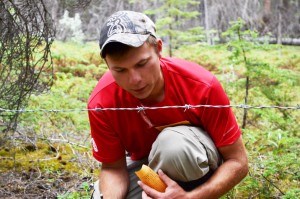
Year-old cattle blood smells like cows rotting in a hot, damp barn. Its pungent scent is thick and heavy, and clings in a film to the back of your throat.
But mixed with canola oil and poured over a mound of moss it is quite effective at luring in hungry bears - which is exactly why TJ Gooliaff stood with a scrunched nose and rubber gloves pouring that mixture from a Nalgene water bottle near the sixth bridge on July 3.
Gooliaff is a field technician with the Foothills Research Institute, which this summer is gathering grizzly bear DNA across a large swath of Alberta, for a population estimate study of the Yellowhead population unit.
The Yellowhead population unit spans from Highway 16 in the north to Highway 11 in the south, running from the BC border in the west to the eastern edge of grizzly range somewhere between Hinton and Edson. Part of that area runs through Jasper National Park, and this year’s study will mark the first time the grizzly population has ever been counted in the south of Jasper.
According to the project’s manager, Tracy McKay, in 2004 the Foothills Research Institute did a similar estimate of the Yellowhead population group, but because of lack of funds, no data was collected in Jasper. McKay said this year’s study will be a repeat of the 2004 study, bolstered by new data collected in the park.
Mark Bradley, a biologist with Parks Canada, said that the information collected will be extremely useful because Parks doesn’t have solid, scientific data confirming grizzly populations in this area.
Bradley explained that most of their information on that population comes from remote monitoring and reports of sightings of mothers and their cubs.
That population information is crucial for Parks’ management policies, because the grizzlies that live in Jasper don’t have as high a reproduction rate as those in other parts of the province, meaning human-related deaths, like train strikes and defense kills, hit quite hard.
“We have a lower density of bears that reproduce more slowly, so we can really only tolerate a tiny amount of extra mortality,” he said.
Grizzlies are listed as a threatened species in Alberta, but Bradley said that Parks doesn’t believe there is currently a problem in Jasper. However, Bradley noted, depending on the population, if more than a very small percentage die of human-related causes “we are in trouble.”
The problem, Bradley continued, is that Parks doesn’t have the personnel or funds to collect in-depth population information, making the Foothills study the perfect way to get it.
Bradley said Parks provided most of the money for this section of the study, and Foothills will do about 95 percent of the work. Such an extensive study of this Grizzly population group was possible because of a combination of funding from the Alberta government, Parks Canada and two forestry companies, McKay added.
June 3, as Gooliaff emptied the cattle blood at one of the “lure” sites, McKay explained that, starting in May, she and her team set up 40-50 rub tree sites, and about 75 lure sites.
At these sites, barbed wire strung at knee-level squares in a pile of wood and debris that is soaked in the aged cattle blood. The blood lures bears to the site, and when they go to investigate, the barbed wire snags and pulls out their fur.
McKay pointed out that it is important there is just blood, and no food reward at the sites, so the bears don’t defend them. With sites set up around the park, safety is a priority for the team.
To keep trail users safe all the sites are set back at least 200 metres from trails, and 500 metres from any facilities. They have also posted signs on trails with lure sites nearby to keep people moving and reduce exposure time.
Every two weeks, a team from Foothills carrying bear spray and GPS units trudges to the sites to collect the hair samples. At the end of the project they will send them away for DNA analysis.
Earlier that day, at one of the rub trees, McKay and Gooliaff spent about 20 minutes collecting and recording all the hairs that had been left from bears rubbing against the bark and barbed wire.
“It’s going to be tricky to group it,” Gooliaff said to McKay, as the pair crouched by the tree, peering intently at a few stray hairs clinging to the barbed wire.
Donning rubber gloves, Gooliaff took a hair from the wire and put it in a small, brown envelope. He called out an identification number, and McKay entered the information into an iPad.
Each barb on the wire has its own number, and the specific barb on which they find a hair can help the team identify different bears.
Aside from labeling and recording each hair they find, the researchers also record which samples are most likely to produce good DNA results, and any other important observations.
After all the hair has been collected, Gooliaff held a Bic lighter to the barbed wire to burn away any access hair and help sterilize the barbs. Teams from Foothills will visit each site four times to collect hair samples, and anything left over could contaminate DNA results when they come back.
With the last of the backcountry lure sites finally up last week, McKay said the project will run until about mid-August. It will take about a month for her and her team to organize the DNA samples, and decide which they will send, she expects a population estimate in the spring of 2015.
Trevor Nichols
[email protected]
